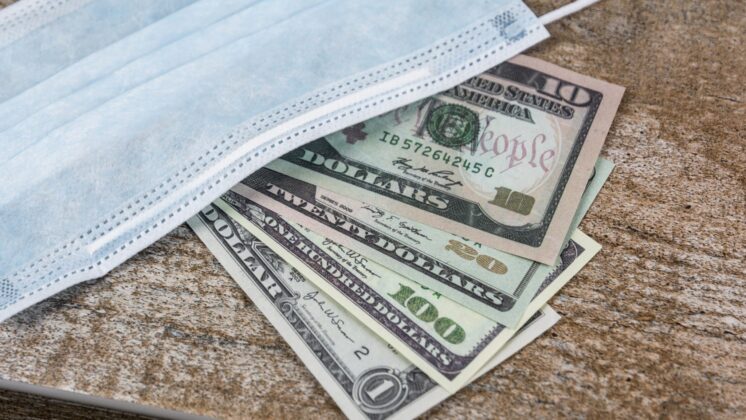Designed to “flatten the curve,” lockdowns have had the unfortunate side effect of flattening the economy. This is particularly true in the service sector, but manufacturing, too, has been affected. Many companies have had to shut or slow down operations as governments decreed their workers not “essential.”
Most governments are helping citizens directly through cash handouts or delays to loan or tax payments. But what are they doing to help businesses?

Japan: A Cash Buoy for Businesses
Japan is spending ¥117.1 trillion (21.1% of 2019 GDP) on five fiscal priorities:
・Preventing the spread of infection and strengthening treatment capacity
・Protecting jobs and businesses
・Regaining economic activities after containment
・Rebuilding a resilient economic structure
・Enhancing readiness for the future
At 16% of 2019 GDP, the protection of jobs and businesses is by far the largest of these measures. On May 1, the government started taking applications for cash handouts of up to ¥2 million to companies that can prove revenue was less than half of any single month in 2019. Self-employed or freelance workers can claim up to ¥1 million.
There are also plans for zero-interest rent loans of up to ¥500,000 per month. Large fixed costs (such as rent) don’t easily move off the income statement. Companies that are struggling to bring customers through their doors still must pay their landlords. This presents a pressing cash-flow problem that the Japanese government has worked into its relief efforts.
Europe: A Dam for a River of Debt
Where Japan is focused on funneling in cash, several European governments are opting for debt relief.
Austria is allowing small and mid-size enterprises (SMEs) to delay debt payments by up to three months. France is letting SMEs postpone rent and utility payments. Italy, one of the hardest-hit countries early in the pandemic, is providing liquidity support to businesses through loan guarantees, interest payment subsidies, rent reductions, and deferred payments of taxes and social security contributions.
The British government is spending £27 billion on measures to support businesses. That includes the Business Interruption Loan Scheme for businesses of all sizes, as well as the temporary waiving of property taxes and grants for small companies and companies in the most affected sectors. Additionally, the Future Fund provides government loans to innovative UK-based companies—if private investors can match the amount.
Russia: Tax Relief, Discounts, and Grants Abound
While its fiscal package is comparatively small at this stage (2.9% of GDP), Russia is doing a lot to help SMEs, especially the smallest of businesses. Those in affected industries will receive a grant to cover one minimum-wage employee for two months. Registered self-employed individuals will be refunded their 2019 taxes and get a discount in 2020. Sole proprietors will get a reduction on their social insurance contributions.

The Middle East: A Mix of Initiatives for Hard-hit Sectors
In the Middle East, there are more varied approaches to business stimulus.
Oman is suspending municipal taxes and some government fees until the end of August. Rent payments for companies in industrial zones will also be delayed for three months.
Qatar has put together a $20.6 billion package (13% of GDP) to shore up small businesses and hard-hit sectors such as hospitality, tourism, retail, and logistics. These measures include six-month exemptions on utility payments, as well as rent for SMEs.
Southeast Asia: Compensation for Over-reliance on Certain Sectors
Malaysia has been hit hard, not only by the direct economic impact of COVID-19, but also by the sharp depreciation in the price of oil. The government there allocated a relatively small budget (about 2.5% of GDP) to temporary tax and social security relief, cash transfers to affected business sectors, and spending on rural infrastructure. It has also created grants for micro-businesses and a fund for working-capital loan guarantees for all businesses affected by the outbreak.
Thailand, Asia’s second-biggest tourist market after China, has put aside 9.6% of GDP for several initiatives including help for farmers and entrepreneurs affected by COVID-19, support for businesses through soft loans, and tax relief.

What’s Next?
The bill for coronavirus will keep rising, but there may come a time when governments can no longer come to the rescue of businesses and citizens. And the more they spend now, at least under the current systems, the more we will have to pay back in taxes later.
In these highly uncertain times, the future is hard to read.
Though it seems like an age ago now, developed countries quickly overcame the first-world problem of running out of toilet paper. Many expected the obliteration of supply chains. But the crisis proved that although certain products may run out for a while, supply chains are in fact quite resilient.
Things will never be quite the same as they were before the lockdowns, but any support governments provide to businesses will buy those businesses time to innovate for more resilient supply chains and the creation of more flexible business models overall.
Now that the wheels of the economy are slowing turning again, we’ll begin to see a clearer picture of what we’ve gained and what we’ve lost. We may still have to distance ourselves physically, but there is no reason why we cannot put our heads together to create new opportunities.



